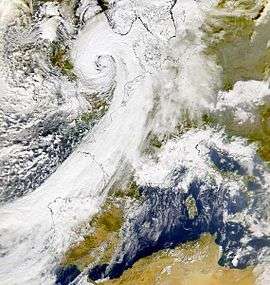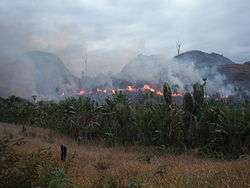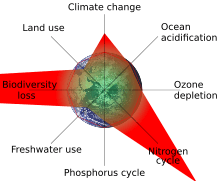Land surface effects on climate
Land surface effects on climate are wide-ranging and vary by region. Deforestation and exploitation of natural landscapes play a significant role. Some of these environmental changes are similar to those caused by the effects of global warming.[1][2][3]
Deforestation effects
Major land surface changes affecting climate include deforestation (especially in tropical areas),[4][5][6][7][8] and destruction of grasslands and xeric woodlands by overgrazing, or lack of grazing. These changes in the natural landscape reduce evapotranspiration, and thus water vapor, in the atmosphere, limiting clouds and precipitation (this may contribute to the retreat of glaciers). It has been proposed, in the journal Atmospheric Chemistry and Physics, that evaporation rates from forested areas may exceed that of the oceans, creating zones of low pressure, which enhance the development of storms and rainfall through atmospheric moisture recycling.[9] The American Institute of Biological Sciences published a similar paper in support of this concept in 2009.[10] In addition, with deforestation and/or destruction of grasslands, the amount of dew harvested (or condensed) by plants is greatly diminished.[11][12][13] All of this helps lead to desertification in these regions.
This concept of land-atmosphere feedback is common among permaculturists, such as Masanobu Fukuoka, who, in his book, The One Straw Revolution, said "rain comes from the ground, not the sky."[14][15]
Deforestation, and conversion of grasslands to desert, may also lead to cooling of the regional climate. This is because of the albedo effect (sunlight reflected by bare ground) during the day, and rapid radiation of heat into space at night, due to the lack of vegetation and atmospheric moisture.[16]
Reforestation, conservation grazing, holistic land management, and, in drylands, water harvesting and keyline design, are examples of methods that might help prevent or lessen these drying effects.[17]
Mountain meteorological effects
Orographic lift
Orographic lift occurs when an air mass is forced from a low elevation to a higher elevation as it moves over rising terrain. As the air mass gains altitude it quickly cools down adiabatically, which can raise the relative humidity to 100% and create clouds and, under the right conditions, precipitation.
Rain shadow
A rain shadow is a dry area on the leeward side of a mountainous area (away from the wind). The mountains block the passage of rain-producing weather systems and cast a "shadow" of dryness behind them. Wind and moist air is drawn by the prevailing winds towards the top of the mountains, where it condenses and precipitates before it crosses the top. In an effect opposite that of orographic lift, the air, without much moisture left, advances behind the mountains creating a drier side called the "rain shadow".
Foehn wind
A föhn or foehn is a type of dry, warm, down-slope wind that occurs in the lee (downwind side) of a mountain range.

It is a rain shadow wind that results from the subsequent adiabatic warming of air that has dropped most of its moisture on windward slopes (see orographic lift). As a consequence of the different adiabatic lapse rates of moist and dry air, the air on the leeward slopes becomes warmer than equivalent elevations on the windward slopes. Föhn winds can raise temperatures by as much as 14 °C (25 °F)[18] in just a matter of minutes. Central Europe enjoys a warmer climate due to the Föhn, as moist winds off the Mediterranean Sea blow over the Alps.
See also
- Forest restoration
- Ecological engineering
- Restoration ecology
- Deforestation and climate change
- Assisted natural regeneration
- Moisture recycling
- Evapotranspiration
- Precipitationshed
- Water cycle
- Tropical rain belt
- Tropical rainforest conservation
- Climate engineering
- Weather modification
- Desert greening
- Al Baydha Project
- Great Plains Shelterbelt
- Great Green Wall, forest initiative in the African Sahel
- Three-North Shelter Forest Program, also known as China's "Green Great Wall"
References
- ↑ http://www.pbslearningmedia.org/resource/ttv10.sci.ess.land/the-effect-of-land-masses-on-climate/
- ↑ https://www2.usgs.gov/faq/node/5601
- ↑ http://pubs.usgs.gov/of/2012/1155/
- ↑ https://www.researchgate.net/publication/273969744_Cascading_effects_of_deforestation_and_drying_trends_on_reduced_forest_resilience_in_the_Amazon_region
- ↑ http://adsabs.harvard.edu/abs/2015EGUGA..1715338Z
- ↑ http://www.nytimes.com/2015/10/11/opinion/sunday/deforestation-and-drought.html?_r=0
- ↑ "Tropical drying trends in global warming models and observations". UCLA Atmospheric and Oceanic Sciences. Retrieved May 13, 2016.
- ↑ Niiler, Eric (April 11, 2016). "Climate Change Is Drying Up Islands". Discovery News. Retrieved May 13, 2016.
- ↑ A. M. Makarieva; V. G. Gorshkov; D. Sheil; A. D. Nobre; B.-L. Li (2013). "Where do winds come from? A new theory on how water vapor condensation influences atmospheric pressure and dynamics" (PDF). Atmos. Chem. Phys. 13: 1039–1056. doi:10.5194/acp-13-1039-2013.
- ↑ Sheil, Douglas & Daniel Murdiyarso (2009). "How forests attract rain: an examination of a new hypothesis" (PDF). BioScience. 59 (4): 341+. doi:10.1525/bio.2009.59.4.12. Archived from the original (PDF) on 2013-03-19.
- ↑ Staniford, Stuart (December 29, 2011). "A Hypothesis about Global Drying". Early Warning. Retrieved May 13, 2016.
- ↑ "Huge parts of world are drying up: Land 'evapotranspiration' taking unexpected turn". ScienceDaily. October 11, 2010. Retrieved May 13, 2016.
- ↑ Peter Greve; Boris Orlowsky; Brigitte Mueller; Justin Sheffield; Markus Reichstein & Sonia I. Seneviratne (2014). "Global assessment of trends in wetting and drying over land". Nature Geoscience. 7 (10): 716–721. doi:10.1038/ngeo2247.
- ↑ http://www.permies.com/t/6471/fukuoka/Rain-ground-sky-Fukuoka
- ↑ 1978 |1975 Sep.] – The One-Straw Revolution: An Introduction to Natural Farming, translators Chris Pearce, Tsune Kurosawa and Larry Korn, Rodale Press.
- ↑ "Deforestation causes cooling, study shows". PhysOrg. November 16, 2011. Retrieved May 13, 2016.
- ↑ Peter Westerveld (December 8, 2010). VIDEO: Reversing climate change is all very simple, says Peter Westerveld (YouTube). TEDxAmsterdam.
- ↑ "South Dakota Weather History and Trivia for January". National Weather Service Weather Forecast Office. February 8, 2006. See January 22 entry.
External links
- YouTube interview with Susan Martinez, Ph.D., on "global drying" theory
- YouTube presentation: "Do forests attract rain?" from the Center for International Forestry Research
- YouTube TEDx presentation by Peter Westerveld on restored land helping to bring rain
- YouTube TED presentation by Allan Savory on using conservation grazing to green desert areas
- YouTube: "Green Desert," a documentary film about the effects of deforestation in Indonesia

